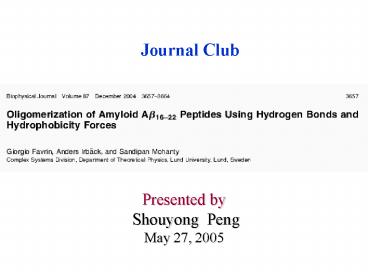Journal Club PowerPoint PPT Presentation
1 / 23
Title: Journal Club
1
Journal Club
Presented by Shouyong Peng May 27, 2005
2
Why Study Abeta16-22 Peptide Aggregation?
- Small peptides are well suited as model systems
for probing the mechanisms of aggregation and
fibril formation.
3
What do They do?
- Investigate the formation and properties of
Abeta16-22 oligomers by - unbiased Monte Carlo simulations of systems with
up to SIX chains, - using a sequence-based atomic model with an
effective potential based on hydrogen bonds and
hydrophobic attractions - (no explicit water molecules)
4
Systems
- Box size 35 Angstrom for three chains
- 44 Angstrom for six chains.
- corresponding to a constant peptide
concentration - Periodic boundary condition.
5
Model and Methods
- Model contains all atoms of the peptide chains,
including hydrogen atoms. - Variables for each amino acid
- phi
- psi
- side-chain torsion angles
6
Interaction potential
Excluded-volume effect Local intrachain
potential Hydrogen-bond energy Effective
hydrophobic interaction
T300K corresponds to kT0.447
7
Excluded-volume Effect
8
Local intrachain potential
q Partial charge -0.20 for N, H /- 0.42 for
C,O
The inner sum represents the interaction between
the partial Charges of the backbone NH and CO
groups in one amino acid
9
Hydrogen-bond energy
ehb 3.1 2.0
r HO distance alpha NHO angle beta HOC
angle
Reduce strength when involving chain ends, Which
tend to be exposed to water
10
Effective hydrophobic interaction
Cij is a measure of the degree of contact
between side chains i and j fraction of
atoms in contact with other side chain
11
Some Tech. details
Simulated tempering Temperature is a dynamical
variable
Study one- and three-chain systems at 8 diff.
Temperatures, ranging from 275 K to 369 K Study
the six-chain system at 9 diff.
Temperatures, ranging from 287K to 369K.
- Two different elementary moves in MC for backbone
atoms - Highly nonlocal pivot move for a single backbone
torsion angle - Semilocal method that works with upto 8 adjacent
- backbone degrees of freedom
- Sidechain angles are updated one by one.
- Rigid body translation and rotation for the whole
chain.
12
Secondary structure determination
Torsion angles for inner amin acids
Parallel or antiparallel orientation end-to-end
vectors scalar product of vectors
13
Schematic HB pattern
14
MC evol.
15
Helix and Strand contents
Nc1 agree with klimov Nc3 not agree.
16
Specific heart
17
Alpha-helicl intermediates?
No sign of an obligatory alpha-helical
intermediate in their model
18
3-chain system
19
6-chain system
20
Figure 6.
21
Other peptides
Small peptide with a low overall
hydrophobicity propensity to aggregate is much
lower ? hydrophobic interaction is the
driving force for aggregation Small peptide
with a significant hydrophobicity but an uneven
distribution of it KFFAAAE predominantly
parallel beta-strand organization ? the model
is capable of generating stable parallel
beta-sheets
22
Examples of low-energy structures
No single dominating free-energy minimum, But
rather a number of more or less degenerate local
minima.
23
Conclusion
- In this model, Abeta16-22 peptides have a high
propensity to self-assemble into aggregated
structures with a high beta-strand content,
whereas isolated peptide is mainly a random coil. - Both parallel and anti-parallel arrangements of
the beta-strands occur in the model, with a
definite preference for the anti-parallel
arrangement. - Anti-parallel preference despite ignoring the
Coulomb interactions. Although Coulomb
interactions might enhance the tendency for
peptides to form beta-sheets with an
anti-parallel organization, their results
strongly suggest that other factors play a
significant role, too. - They did not observe an absolute free-energy
minimum, but rather several minima corresponding
to different supramolecular structures, all
consisting of arrangements of beta-strands. - Apart from single beta-sheets, laminated
multisheet structures were found near free-energy
minima for the six-chain system.

